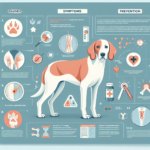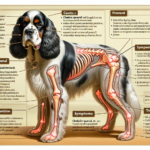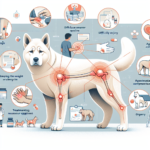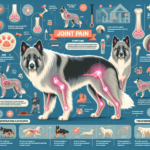American Leopard Hound Joint Pain: Causes, Symptoms, Prevention, and Treatment

Introduction
The American Leopard Hound, also known as the Leopard Cur, is a versatile and robust breed known for its hunting prowess and striking coat patterns. Originating in the United States, this breed has a rich history of being used for hunting various game, including raccoons and wild boar. With a keen sense of smell, high intelligence, and an energetic disposition, the American Leopard Hound is a favorite among hunters and active families alike.
Despite their generally robust health, American Leopard Hounds are not immune to certain health issues. Among these, joint pain is a significant concern that can affect their quality of life. Joint health is particularly crucial for this breed due to their high activity levels and the physical demands placed on them during hunting and other activities.
Breed-Specific Joint Pain Risks
Genetic Predisposition
Like many other breeds, the American Leopard Hound is genetically predisposed to certain joint-related issues. Hip dysplasia, a condition where the hip joint doesn’t fit properly into the hip socket, is relatively common. This can lead to arthritis and significant pain over time. Elbow dysplasia, another genetic condition, affects the elbow joints and can also result in chronic pain and mobility issues.
Age-Related Risks
As American Leopard Hounds age, the risk of developing joint pain increases. While they are generally healthy in their younger years, signs of joint issues often become apparent as they reach middle age. Owners should be particularly vigilant once their dog reaches around 5-7 years old, as this is when age-related joint problems are more likely to manifest.
Activity Level and Joint Stress
The American Leopard Hound is an active and energetic breed, often used for hunting and other high-intensity activities. While their activity level is beneficial for their overall health, it can also contribute to joint stress. Repetitive motions, jumping, and running on uneven terrain can exacerbate existing joint issues or lead to new ones.
Common Symptoms of Joint Pain in American Leopard Hounds
General Symptoms
- Limping: One of the most noticeable signs of joint pain is limping or favoring one leg over another.
- Stiffness: Dogs may show stiffness, especially after resting or sleeping.
- Reluctance to Move: A dog in pain may be reluctant to engage in activities they once enjoyed, such as running or jumping.
- Swelling: Visible swelling around the joints can be a sign of inflammation.
- Behavioral Changes: Irritability or changes in behavior can also indicate discomfort.
Breed-Specific Symptoms
For the American Leopard Hound, symptoms like a noticeable decrease in hunting performance or reluctance to participate in high-energy activities can be particularly telling. Given their natural inclination for activity, any significant change in their enthusiasm for exercise should be closely monitored.
When to Consult a Vet
If you notice any of the above symptoms, it’s crucial to consult a veterinarian promptly. Early diagnosis and treatment can significantly improve the quality of life for your American Leopard Hound. Persistent limping, severe stiffness, or any signs of pain should not be ignored.
Preventive Measures for Joint Health
Exercise Recommendations
Regular, moderate exercise is essential for maintaining joint health in American Leopard Hounds. Activities like swimming, which provide a full-body workout without putting excessive strain on the joints, are highly recommended. Avoid high-impact activities like jumping or running on hard surfaces, especially for older dogs.
Dietary Suggestions
A balanced diet rich in essential nutrients can support joint health. Foods high in omega-3 fatty acids, glucosamine, and chondroitin are particularly beneficial. These nutrients help reduce inflammation and support cartilage health. Consider incorporating supplements if your dog’s diet lacks these essential nutrients.
Weight Management
Maintaining a healthy weight is crucial for reducing joint stress. Excess weight puts additional pressure on the joints, exacerbating existing issues and potentially leading to new ones. Regular weigh-ins and portion control can help keep your American Leopard Hound at an optimal weight.
Early Screening and Monitoring
Regular veterinary check-ups are essential for early detection of joint issues. Screening tests like X-rays can help identify problems before they become severe. Early intervention can significantly improve outcomes and quality of life.
Treatment Options for Joint Pain
Non-Surgical Treatments
Non-surgical treatments are often the first line of defense against joint pain. These can include:
- Medications: Anti-inflammatory drugs and pain relievers can help manage symptoms.
- Physical Therapy: Specialized exercises can strengthen the muscles around the joints, providing better support.
- Lifestyle Adjustments: Modifying activities to reduce joint stress can also be beneficial.
Surgical Options
In severe cases, surgical intervention may be necessary. Common surgeries for joint issues include:
- Hip Replacement: This surgery involves replacing the damaged hip joint with an artificial one.
- Arthroscopy: A minimally invasive procedure used to diagnose and treat joint issues.
- Joint Fusion: This surgery fuses the bones in a joint to reduce pain and improve stability.
Alternative Therapies
Alternative treatments can also provide relief for joint pain. These include:
- Acupuncture: This ancient practice can help reduce pain and inflammation.
- Hydrotherapy: Water-based exercises can improve mobility without stressing the joints.
- Massage: Regular massages can help alleviate muscle tension and improve circulation.
Lifestyle and Management Tips
Daily Care Routine
A consistent daily care routine can help manage joint pain. This might include gentle morning exercises, a balanced diet, and regular rest periods. Monitoring your dog’s behavior and adjusting activities as needed can also make a significant difference.
Modifying the Home Environment
Making your home more comfortable for a dog with joint pain is essential. Consider adding ramps to help them navigate stairs and providing orthopedic beds for better support. Non-slip mats can also prevent accidents on slippery floors.
Long-Term Management
Long-term management of joint pain involves a combination of regular veterinary care, appropriate exercise, and a balanced diet. Consistency is key to keeping your American Leopard Hound active and happy despite joint issues.
FAQs About American Leopard Hounds and Joint Pain
What are the early signs of joint pain in American Leopard Hounds?
Early signs include limping, stiffness, reluctance to move, and behavioral changes. If you notice any of these symptoms, consult your veterinarian promptly.
Can joint pain be prevented in American Leopard Hounds?
While genetic predispositions can’t be entirely prevented, maintaining a healthy weight, providing a balanced diet, and regular exercise can significantly reduce the risk of joint pain.
Are there specific exercises that are better for joint health?
Yes, low-impact exercises like swimming and controlled walking are excellent for maintaining joint health without putting excessive strain on the joints.
What dietary supplements are beneficial for joint health?
Supplements containing glucosamine, chondroitin, and omega-3 fatty acids are particularly beneficial for joint health.
When should I consider surgical options for my dog’s joint pain?
If non-surgical treatments are ineffective and your dog is experiencing severe pain or mobility issues, consult your veterinarian about potential surgical options.
Conclusion
Joint pain is a significant concern for American Leopard Hounds, but with proper care and attention, it can be managed effectively. Regular exercise, a balanced diet, and early screening are crucial for maintaining joint health. If you notice any signs of joint pain, consult your veterinarian promptly to explore the best treatment options. By taking preventive measures and staying vigilant, you can ensure your American Leopard Hound enjoys a happy, active life.




